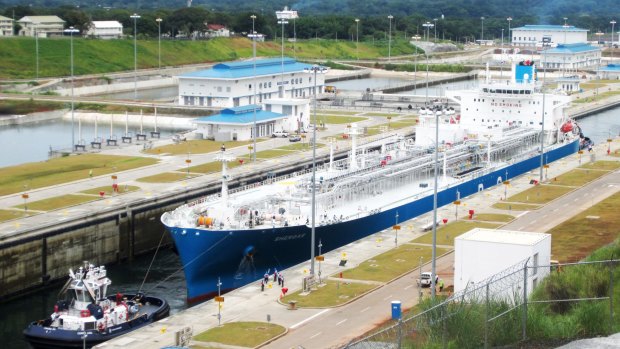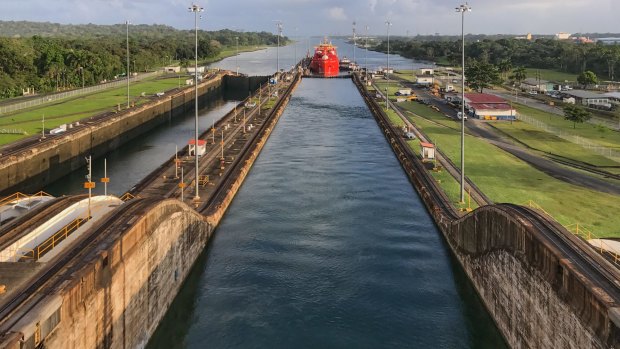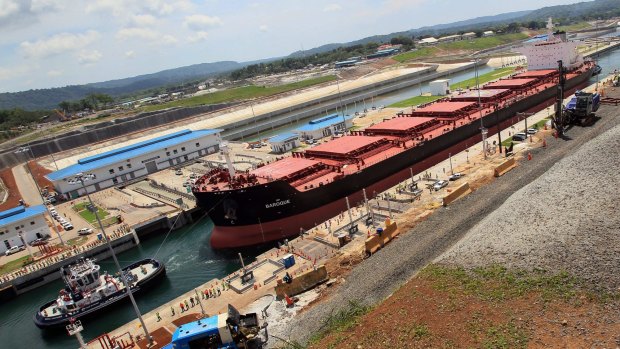This was published 6 years ago
The Panama Canal mark II: Third traffic lane for this engineering marvel

It takes a ship about three hours to pass through the three lock chambers of the Panama Canal.Credit: Rob McFarland
Of all the mind-bending facts and figures about the expansion of the Panama Canal, the one that surprises me most is that this isn't the first time it's been attempted. Twenty-five years after the canal opened in 1914, work began on a second set of locks and approach channels to accommodate America's larger warships. The project ran for several years before being cancelled after World War II.
In 2007, Panama decided to have another crack at it. The plan was to build a new set of larger locks at both ends of the canal to create a third lane of traffic (the existing locks already allow simultaneous passage in both directions), thereby allowing bigger vessels to use this handy 77-kilometre shortcut between the Atlantic and the Pacific. The project was supposed to finish in 2014 to coincide with the canal's 100th anniversary. However, disputes and delays meant it overran by almost two years. Finally, on June 26, 2016, the Cosco Shipping Panama container ship became the first vessel to use the new locks, paying the tidy sum of $US575,545 ($A736,294) for the privilege.
The canal has two visitor centres where you can learn more about this engineering marvel. Most people visit the one at the Miraflores Locks, 10 kilometres outside of Panama City, but I'd recommend taking the scenic Panama Canal Railway to Colon to visit the newer complex at the Atlantic end. The trip takes about an hour and offers tantalising glimpses of ships transiting the canal interspersed with shipyards and bird-filled wetlands from the train's glass-domed observation car.

On June 26, 2016, the Cosco Shipping Panama container ship became the first vessel to use the new Panama Canal locks, paying the tidy sum of $US575,545 ($A736,294) for the privilege.Credit: SHUTTERSTOCK
Entrance to the Agua Clara visitor centre (named because the water is clearer on the Atlantic side) costs 15 balboas ($19) and includes a 12-minute video presentation plus access to an observation terrace.
Whenever I watch one of these films I feel faint from the bewildering complexity of a project of this scale. The expansion involved a new 6.1-kilometre access channel at the Pacific end of the canal, deepening and widening both canal entrances and building two sets of locks with 16 lock gates weighing more than 3000 tonnes each.
A guide shows me a video on his phone of one of the gates being manoeuvred into place by remote control – a painstaking process of inching it backwards and forwards on a bed of rollers – surely one of the most stressful parallel parks in history.

The ship MN Baroque during the first crossing test at lock Agua Clara last yearCredit: AAP
All of which raises the question: why go to all this trouble when you already have a perfectly good shipping shortcut that's been used by more than a million vessels? Because container ships are getting bigger and Panama is missing out on toll revenue. Even though the budget for the expansion ballooned way above the initial $US5.25billion estimate, the new larger locks can handle ships with almost 13,000 containers. Plus the third lane of traffic doubles the canal's capacity to about 30,000 vessels a year.
The toll paid is based on a ship's weight, so that's a compelling incentive to increase capacity. One of the highest tolls paid last year was a staggering $US829,468 by the MOL Benefactor which transited on July 1. Incidentally, the smallest on record was by Richard Halliburton who swam the length of the canal in 1928 for the princely sum of US36¢.
The new locks are 60 per cent wider and 40 per cent longer than the old ones, which means they could accommodate the Empire State Building should someone decide to pop it on a barge and ship it to Peru.
Although the new locks could comfortably house the world's largest cruise ship (the 362-metre-long Harmony of the Seas), unfortunately there isn't enough clearance under the Bridge of the Americas to allow it to pass through the canal.
Even though the new locks are bigger, they use less water for each transit than the old ones thanks to three vast reservoirs which recycle 60 per cent of the water from each lock chamber. A large-scale reforestation project helped offset the emissions created during the expansion and the fact that more boats can now use the shortcut should mean less global CO₂ emissions from shipping.
It takes a ship about three hours to pass through the three lock chambers, which, let's face it, doesn't sound like the world's most riveting spectator sport. Yet, as I watch Shergar, a 225-metre LPG tanker, carefully make its way between the second and third chambers, I find the spectacle strangely captivating. From the observation deck I have a clear view of the length of the lock plus the gaggle of ships waiting patiently on either side.
Unlike the old locks, where ships are pulled through by locomotives, the new ones use tugs and the ships' own engines. Each chamber raises the ship by nine metres until it eventually reaches the canal, 27 metres above sea level.
One oddity is that in certain places the canal isn't wide enough for two Neopanamax ships (the classification of the vessels the new locks can accommodate) to pass each other. So the passage of these ships has to be carefully co-ordinated to avoid an embarrassing mid-canal stand-off ("You reverse. No, you reverse. But I'm bigger…").
The new locks can also handle traffic only in one direction so three Pacific-bound ships are allowed through each morning then the direction is reversed in the afternoon.
I presumed the locks themselves would be off limits to visitors and protected by a ferocious curtain of security. However, at certain times of day you can drive over both the new and old lock gates and it's worth hanging around to see them from this perspective.
Although the decision to expand the canal was approved by about 80 per cent of the voters in a referendum in 2006, the constant delays and escalating costs quickly eroded public confidence.
"During construction, people were saying, 'It's never going to be finished and it's a waste of money,'" says my guide. "But now, everyone is very proud." He smiles. "In Panama, we have short memories."
FIVE MORE FAMOUS CANALS
SUEZ CANAL
Originally opened in 1869, this 193-kilometre shortcut between the Mediterranean Sea and the Red Sea in Egypt is used by about 17,000 vessels a year as an alternative to the treacherous trip around the southern tip of Africa.
WHITE SEA CANAL
Thousands of Russian Gulag prisoners died during the construction of this 227-kilometre canal. Its shallow depth, however, means less than 50 boats a day now use it to get between the White Sea and the Baltic Sea.
KIEL CANAL
Connecting the Baltic Sea with the North Sea, the 98-kilometre-long Kiel Canal passes through the German state of Schleswig-Holstein and saves ships a 1000-kilometre detour around Denmark's Jutland peninsula.
EUROPA CANAL
Originally started in the 1930s, this important maritime gateway has been extended several times and now links three rivers – the Rhine, Main and Danube – with the North Sea and the Black Sea.
BEIJING-HANGZHOU GRAND CANAL
At almost 1800 kilometres, the Beijing-Hangzhou Grand Canal is the world's longest man-made waterway. Work started on the project as far back as the 5th century BC and today the UNESCO World Heritage-listed canal connects Beijing with Hangzhou as well as linking the Yellow and Yangtze Rivers.
See also: Captain's nightmare - Cruising's tightest squeeze
See also: Panama - home of the world's greatest coffee, really
TRIP NOTES
MORE
FLY
Air New Zealand flies via Auckland to Houston. United flies direct from Houston to Panama City. See airnewzealand.com.au or united.com
STAY
The five-storey, 50-room American Trade Hotel in Panama City oozes colonial charm with an impressive rooftop pool and an intimate jazz club. See acehotel.com/panama
TOUR
Latin America specialist Chimu Adventures can create a tailor-made Panama itinerary including flights, accommodation, transfers and tours. Phone 1300 773 231; see chimuadventures.com
Rob McFarland was a guest of Air New Zealand and Chimu Adventures.
Sign up for the Traveller Deals newsletter
Get exclusive travel deals delivered straight to your inbox. Sign up now.